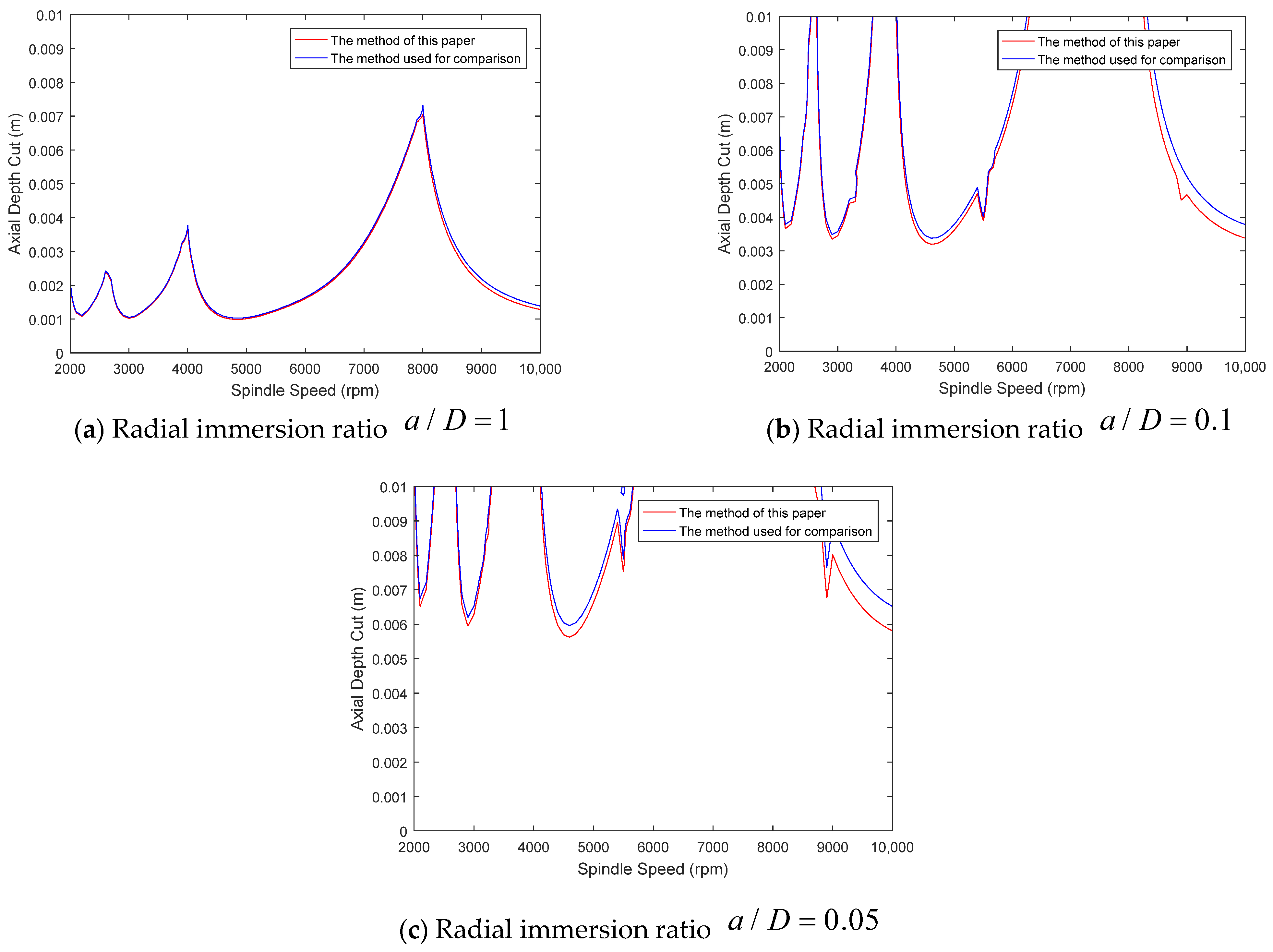The Prediction of Stability in the Time-Delayed Milling Process of Spiral Bevel Gears Based on an Improved Full-Discretization Method
Abstract
:1. Introduction
2. Mathematical Model and Algorithm
3. Validation
4. Single-Degree-of-Freedom Milling Model
5. Double-Degree-of-Freedom Milling Model
6. Conclusions and Future Works
Author Contributions
Funding
Data Availability Statement
Conflicts of Interest
References
- Smith, S.; Tlusty, J. Efficient Simulation Programs for Chatter in Milling. CIRP Ann. 1993, 42, 463–466. [Google Scholar] [CrossRef]
- Sridhar, R.; Hohn, R.E.; Long, G.W. A stability algorithm for the general milling process. ASME J. Eng. Ind. 1968, 90, 330–334. [Google Scholar] [CrossRef]
- Minis, I.; Yanushevsky, R. A new theoretical approach for the prediction of machine tool chatter in milling. J. Eng. Ind. 1993, 115, 1–8. [Google Scholar] [CrossRef]
- Altintas, Y.; Budak, E. Analytical prediction of stability lobes in milling. CIRP Ann. Manuf. Technol. 1995, 44, 357–362. [Google Scholar] [CrossRef]
- Yang, W.A.; Huang, C.; Cai, X.; You, Y. Effective and fast prediction of milling stability using a precise integration-based third-order full-discretization method. Int. J. Adv. Manuf. Technol. 2020, 106, 4477–4498. [Google Scholar] [CrossRef]
- Ji, Y.; Wang, X.; Liu, Z.; Wang, H.; Jiao, L.; Zhang, L.; Huang, T. Stability prediction with simultaneously considering the multiple factors coupling effects-regenerative effect, mode coupling, and process damping. Int. J. Adv. Manuf. Technol. 2018, 97, 2509–2527. [Google Scholar] [CrossRef]
- Dai, Y.B.; Li, H.; Liu, B.; Yang, C. Calculation boundary vulnerability of numerical algorithm in milling stability prediction. Int. J. Adv. Manuf. Technol. 2022, 119, 8271–8286. [Google Scholar] [CrossRef]
- Shi, Z.; Liu, L.; Liu, Z.; Zhang, X. Frequency-domain stability lobe prediction for high-speed face milling process under tool-workpiece dynamic interaction. Proc. Inst. Mech. Eng. Part B J. Eng. Manuf. 2016, 231, 2336–2346. [Google Scholar] [CrossRef]
- Zhang, C.; Yan, Z.; Jiang, X. Numerical integration scheme–based semi-discretization methods for stability prediction in milling. Int. J. Adv. Manuf. Technol. 2021, 115, 397–411. [Google Scholar] [CrossRef]
- Ding, Y.; Zhu, L.M.; Zhang, X.J.; Ding, H. Second-order full-discretization method for milling stability prediction. Int. J. Mach. Tools Manuf. 2010, 50, 926–932. [Google Scholar] [CrossRef]
- Cheng-Ying, L.; Jie, Z.; Wei, L.; Zhi, Z. A Full-discretization Method for Milling Stability Predication Based on Time-step Control. Modul. Mach. Tool Autom. Manuf. Tech. 2017, 12, 59–61. [Google Scholar]
- Ding, Y.; Zhu, L.; Zhang, X.; Ding, H. A full-discretization method for prediction of milling stability. Int. J. Mach. Tools Manuf. 2010, 50, 502–509. [Google Scholar] [CrossRef]
- Sellmeier, V.; Denkena, B. Stable islands in the stability chart of milling processes due to unequal tooth pitch. Int. J. Mach. Tools Manuf. 2011, 51, 152–164. [Google Scholar] [CrossRef]
- Sims, N.; Mann, B.; Huyanan, S. Analytical prediction of chatter stability for variable pitch and variable helix milling tools. J. Sound Vib. 2008, 317, 664–686. [Google Scholar] [CrossRef]
- Quintana, G.; Ciurana, J.; Ferrer, I.; Rodrı´guez, C.A. Sound mapping for identification of stability lobe diagrams in milling processes. Int. J. Mach. Tools Manuf. 2009, 49, 203–211. [Google Scholar] [CrossRef]
- Jin, G.; Qi, H.J.; Cai, Y.J.; Zhang, Q.C. Stability prediction for milling process with multiple delays using an improved semi- discretization method. Math. Methods Appl. Sci. 2015, 39, 949–958. [Google Scholar] [CrossRef]
- Ozoegwu, C.G. High order vector numerical integration schemes applied in state space milling stability analysis. Appl. Math. Comput. 2016, 273, 1025–1040. [Google Scholar] [CrossRef]
- Merdol, D.S. Virtual Three-Axis Milling Process Simulation and Optimization. Ph.D. Thesis, University of British Columbia, Vancouver, BC, Cananda, 2008. [Google Scholar]
- Jin, G.; Zhang, Q.; Hao, S.; Xie, Q. Stability prediction of milling process with variable pitch cutter. Math. Probl. Eng. 2013, 2013, 932013. [Google Scholar] [CrossRef]
- Jin, G.; Zhang, Q.; Hao, S.; Xie, Q. Stability prediction of milling process with variable pitch and variable helix cutters. Proc. Inst. Mech. Eng. Part C J. Mech. Eng. Sci. 2014, 228, 281–293. [Google Scholar] [CrossRef]
- Dai, Y.; Li, H.; Xing, X.; Hao, B. Prediction of chatter stability for milling process using precise integration method. Precis. Eng. 2017, 52, 152–157. [Google Scholar] [CrossRef]


| Method of This Paper | Method Used for Comparison [16] | |
|---|---|---|
| 1 | 147.4 | 170.2 |
| 0.1 | 155.0 | 197.5 |
| 0.05 | 150.7 | 182.3 |
| Method of This Paper | Method Used for Comparison [16] | |
|---|---|---|
| 1 | 122.6 | 140.9 |
| 0.1 | 128.1 | 157.3 |
| 0.05 | 130.6 | 152.8 |
Disclaimer/Publisher’s Note: The statements, opinions and data contained in all publications are solely those of the individual author(s) and contributor(s) and not of MDPI and/or the editor(s). MDPI and/or the editor(s) disclaim responsibility for any injury to people or property resulting from any ideas, methods, instructions or products referred to in the content. |
© 2024 by the authors. Licensee MDPI, Basel, Switzerland. This article is an open access article distributed under the terms and conditions of the Creative Commons Attribution (CC BY) license (https://creativecommons.org/licenses/by/4.0/).
Share and Cite
Tian, C.; Wang, T.; Tian, Y. The Prediction of Stability in the Time-Delayed Milling Process of Spiral Bevel Gears Based on an Improved Full-Discretization Method. Mathematics 2024, 12, 2061. https://doi.org/10.3390/math12132061
Tian C, Wang T, Tian Y. The Prediction of Stability in the Time-Delayed Milling Process of Spiral Bevel Gears Based on an Improved Full-Discretization Method. Mathematics. 2024; 12(13):2061. https://doi.org/10.3390/math12132061
Chicago/Turabian StyleTian, Chong, Taiyong Wang, and Ying Tian. 2024. "The Prediction of Stability in the Time-Delayed Milling Process of Spiral Bevel Gears Based on an Improved Full-Discretization Method" Mathematics 12, no. 13: 2061. https://doi.org/10.3390/math12132061
APA StyleTian, C., Wang, T., & Tian, Y. (2024). The Prediction of Stability in the Time-Delayed Milling Process of Spiral Bevel Gears Based on an Improved Full-Discretization Method. Mathematics, 12(13), 2061. https://doi.org/10.3390/math12132061






